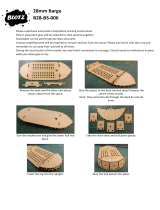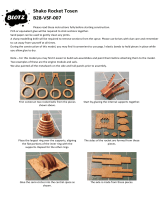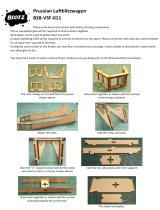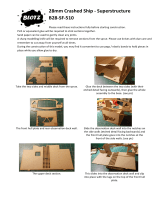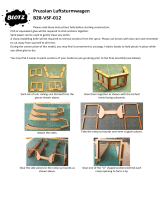Page is loading ...

TECHNICAL DATA:
The Sultan Dhow
Model no: 22165
Degree of difficulty:
Length: 470mm (1816/32in)
Height: 420mm (16 18/32in)
Beam: 125mm (4 3/4in)
Scale: 1:60
The dhow is a type of boat with two or three
masts and rigged with lateen sails. For centuries,
these boats have plied their trade in the Persian
Gulf and the Oman Sea and further afield in Malaysia
and Zanzibar. Until the 1960s, dhows regularly sailed
between the Persian Gulf and East Africa with cargos
of spices and timber. Today, dhows continue trading
and are still hand-built in Zanzibar.
Not suitable for children under 14 years of age. Model for collectors only.

DHOWS
Most dhows sail mainly in
coastal waters, but larger
versions are capable of long,
deep-sea voyages, during which
sailors once navigated with the kamal,
a simple instrument for determining
latitude with a surprising degree of
accuracy. Smaller dhows are also used
on great rivers, such as the Nile.
Dhows have always been used for
peaceful purposes, rather than as
fighting ships. They are typically used
to transport people and goods – and
in the past, in the heyday of the Arab
slave trade, people as goods. They
make excellent fishing boats, and are
used as bases for pearl divers.
Sailing on the monsoon winds
Until the mid-20th century, dhows
would sail south on the monsoon
winds of late winter from Kuwait,
Oman and other Arab states, taking
dates, salt fish and other goods to
East Africa. They would return to
Arabia a few months later, laden with
timber, cloves and other goods, when
the winds changed in their favour.
These dhows had crews of about a
dozen, and displaced 300–500 tonnes.
Similar boats can be found on these
routes today, although they are
usually fitted with auxiliary engines.
A typical dhow has two masts,
with a mainsail considerably bigger
than the mizzensail, and a long, thin
wooden hull with a sharp, upward-
pointing bow. The traditional method
for making a dhow, known as shell-
building, was different from that
employed in Europe, where
shipwrights first built the framework
of the hull, then fixed planks to the
Dhows have been plying the seas for two millennia or more. Their size,
shape and construction methods have varied through the centuries and
between various countries. The basic principle of a wooden sailboat with
lateen sails – a shape developed by the Arabs – is still used today in the
Red Sea and the Persian Gulf, and in the Indian Ocean, from the north of
Madagascar to the Bay of Bengal.
Below: Dhows have been a familiar sight in
coastal waters of Arabia for millennia.
DeAgostini
1 THE SULTAN DHOW

THE KAMAL
This navigational device was first used by Arabs in the
9th century. A piece of cord, with knots at fixed
intervals, is threaded through a hole in the centre of a
wooden rectangle. One end of the cord is held in the
teeth and the other at arm’s length. The user sights the
lower edge of the rectangle against the horizon, and the
upper to just occlude Polaris. The dhow’s latitude is
measured by counting the knots between the teeth and
the wood. Kamals were not used outside the Tropics, as
Polaris is too high in the north and sometimes below the
horizon in the south.
ribbing. In shell-building, by contrast,
the outer skin of the hull is built up
from the base.
In the case of the earliest dhows,
this was a simple dugout. Thin teak
planks were sewn to the side of this
to build up a hull. Over the centuries,
a keel replaced the dugout, but the
basic technique, in which the
shipwright created a vessel one plank
at a time, remained unaltered. One
advantage of this technique was its
adaptability. Changes could easily be
made during the process of
construction, simply by adding more
planks, altering their shape, or
attaching them at a different angle.
After European ships – first the
carracks and caravels of the
Portuguese, and then galleons – began
to appear in the Indian Ocean in the
16th century, the dhow-builders
began to nail the planks together
rather than sew them, but shell-
building continued to be the favoured
method.
Several types of dhow evolved
over the centuries to suit different
purposes. They are all characterized
by size and by the shapes of their
hulls. The baghlah, which is now no
longer built, was made for deep-sea
sailing, for example, and carried a
comparatively large crew of 30 or
more. It featured a flat, squared-off
stern, called a transom – with five
windows, and a high poop deck which
was reminiscent of those seen on
the grand European galleons of the
16th century.
Decorated dhows
The ghanjah was another large,
ocean-going dhow with an up-curving
stem – the timber at the front of the
boat – and a sloping transom, which
was usually highly decorated with
often ornate carvings.
Above: A boum in Bandar Kong, a port town of Iran by the Persian Gulf. Boums were
sailships until the 1960s when most were converted to diesel power like this one.
The dhow trade routes from
Arabia to India and East Africa
represent the most long-lasting
tradition of commercial seafaring
in world history.
The battil is a double-ended dhow,
with a long stem post, which ends in a
large, clubbed finial, and a stern post,
which owners often decorate with
pieces of worked leather and shells,
particularly cowries.
Sailing in calmer waters
The badan, a smaller double-ended
dhow with a shallower draught, was
intended to be sailed in coastal waters
and on rivers. It was similar to the
felucca, made for the protected
waters of the eastern Mediterranean
and the Red Sea. They can safely be
crewed by two or three people, and
are still in use today on the Nile,
ferrying up to a dozen people (and
often livestock) across or up and
down the river – just as they have
done for centuries.
Above: Dhows continue to provide
a cheap, reliable form of transport
in Arab waters.
Peter Ifland, author of Taking the Stars: Celestial Navigation from Argonauts to Astronauts
2 THE SULTAN DHOW

GENERAL TIPS
1. Follow all assembly steps CAREFULLY.
Take all the time you need. First look at the
photos and read all the documentation included
in the kit, as it will help you assemble the
model correctly:
•Parts list with Dimensions and Materials.
•Cut Sheet with precision-cut numbered parts.
•These instructions.
3. To cut to size and identify the parts which
are not prefabricated, look at the parts list
where you will find:
•Part number.
•Part description.
•Number of same parts to be cut and used
in the model.
•Part dimensions (thickness, width, length,
in that order).
•Material used to make the parts (subject to
modification by prior notification.
ATTENTION! Assemble under adult supervision. Unsuitable for children under 14. To
assemble this model we recommend that you follow the step-by-step guide.
2. To remove the wood pieces (see Cut
Sheets), carefully cut the tiny strands joining
them to the sheet. Use the Cut Sheets to
identify fully the precision-cut parts.
After removing the parts from the sheets to
use them during assembly, carefully sand them
before gluing in place.
Given the nature and origin of the wood,
there may be slight differences in the tone
or colour of some material.
1
2
3
4. To ensure the perfect adjustment of cast
metal parts, go over the edges with a small
file before fitting to eliminate possible burrs
and impurities.
4
5. To give a more authentic appearance to
the ship’s sails, dye them in some tea. When
completely dry, add them to the ship without
ironing them.
5
6. For parts that need bending or curving,
dampen them in water for greater flexibility.
You can also use a tool called a bending press,
which is highly useful during assembly.
6
7. Before mounting the pulley blocks or dead-
eyes, it is best to enlarge the holes with a
0.75mm diameter drill.
7
GLUES
Apply glue sparingly and in strict accordance
with the manufacturer’s instructions. There are
three types of glues that can be used to
assemble the model.
White glue
This is also known as carpenter’s glue or PVA.
It can be applied directly or with a brush to
one of the parts to be glued. Clean off any
excess glue immediately after joining the
parts to avoid staining when fully dry.
Contact glue
This glue can be applied with either a brush or
a flat spatula. Apply a thin coat to both surfaces
to be joined. Before joining the parts, leave for
approximately five minutes. After joining the
parts, apply light pressure and remove any
excess glue.
Quick-drying glue
Apply a tiny amount directly to the point where
the parts are to be joined. It is very important
that the parts are correctly positioned as you
will not be able to move the parts again to set
them correctly.
PUTTIES
Use regular stopping putty for wood. Read the
manufacturer’s instructions carefully!
Applying putty
To fill holes or cracks in the ship’s hull, apply
the putty with a flat spatula. Allow to dry and
softly sand the entire surface of the hull to level
off the putty.
VARNISHES
Use clear (not coloured) stopping varnish. Read
the manufacturer’s instructions carefully!
Applying varnish
Use a brush to apply varnish to wood. Sand
the surface and thoroughly clean the part
before varnishing. Varnish as follows:
1. Apply a first coat and allow to dry.
2. When dry, sand and clean the part.
3. Repeat Steps 1 and 2.
4. Apply a third coat and allow to dry.
5. When dry, polish the part using steel wool.
PAINTS
Use acrylic (water-based) paints. Read the
manufacturer’s instructions carefully!
Applying paint
Use a paintbrush. Sand the surface and clean the
part thoroughly before painting. Paint in the
following order.
1. Apply a coat of varnish to prepare the
surface to be painted. Allow the part to dry.
2. When dry, sand and clean the part.
3. Apply a first coat of paint and allow to dry.
4. When dry, apply a second coat of paint.
8
1 THE SULTAN DHOW: LIST OF PARTS

1Vertical keel
2-13 Frames
14 Stern strengtheners
15 Bow strengtheners
16 Main deck
17 Nails
18 Stern deck
19 Stern bulkhead
20 Bow deck
21 Small central deck
22 Plates on first plating
23 Stern
24 Keel
25 Sternpost
26 Clear strakes on second plating
27 Dark strakes on second plating
28 Wide rubbing strake
29 Narrow rubbing strake
30 Deck plate
31 Central interior ends
32 Vertical interior ends on stern
33 Interior ends on stern
34 Transverse ends on stern
35 Interior ends on bow
36 Transverse first end on bow
37 Transverse second end on bow
38 Stranchions on bulwarks
39 Lower lengthwise frames in the gap on the main deck
40 Lower transverse frames in the gap on the main deck
41 Upper lengthwise frames in the gap on the main deck
42 Upper transverse frames in the gap on the main deck
43 Central side gunwale covers
44 Side gunwale covers on bow
45 Side gunwale covers on stern
46 Gunwale cover on stern
47 Stanchion strengtheners
48 Rudder blade
49 Small hinges on rudder
50 Large hinges on rudder
51 Side embellishments on stern
52 Side mid-embellishments on stern
53 Rudder tiller
54 Side walls on the rails
55 Handrails
56 Side columns on the rails
57 Long pillars on the canopy
58 Short pillars on the canopy
59 First beam on the canopy
60 Second beam on the canopy
61 Third beam on the canopy
62 Lashing on ladders
63 Mast hole for mizzenmast
64 Sides on ladders
65 Steps on ladders
66 Top of stern rail
67 Tops of bow rail
68 Columns for the bow and stern rails
69 Exterior lengthwise frames for the load hatch
70 Exterior transverse frames for the load hatch
71 Interior lengthwise frames for the load hatch
72 Interior transverse frames for the load hatch
73 Covers for the load hatch
LIST OF PARTS
Required extra tools and accessories:
•White glue (item 27601)
•Quick-drying glue (item 27611)
•Hand drill (item 27018)
•Varnish 200cc pot (item 27621)
•Cutter no.1
•Sandpapers – medium grain (240)
•Sandpapers (cont) – very fine grain (1000)
Recommended extra tools and accessories:
•Hammer (item 27017)
•Plank bender (item 27024)
•Mini clamps (item 27029)
•Saw (item 27042)
•Thread scissors (item 27060)
All tools and
materials are
available from
www.model-space.co.uk
Plywood
Plywood
Plywood
Plywood
Plywood
Brass
Plywood
Plywood
Plywood
Plywood
Basswood
Sapele
Sapele
Sapele
Basswood
Sapele
Walnut
Walnut
Basswood
Sapele
Sapele
Sapele
Sapele
Sapele
Sapele
Sapele
Sapele
Walnut
Walnut
Walnut
Walnut
Walnut
Walnut
Walnut
Walnut
Sapele
Sapele
Brass strapping
Brass strapping
Walnut
Walnut
Sapele
Sapele
Walnut
Walnut
Sapele
Sapele
Sapele
Sapele
Sapele
Cotton thread
Sapele
Sapele
Sapele
Sapele
Sapele
Sapele
Sapele
Sapele
Sapele
Sapele
Walnut
1
12
2
2
1
500
1
1
1
1
38
1
1
1
20
34
2/2
2/2
14/26/22/22
2
2
2
2
2
1
1
8/4/24
2
2
2
2
2
2
2
1
2
1
4
2
20
2
1
2
4/1
18
2
4
1
1
1
24
1
6
12
1
2
13
2
2
2
2
10
Pref 4
Pref 4
Pref 4
Pref 4
Pref 1.5
10mm
Pref 1.5
Pref 1.5
Pref 1.5
Pref 1.5
1.5x5x400
Pref 4
4x6x250
Pref 4
0.6x5x400
0.6x5x400
2x3x12/400
2x2x16/400
1x4x55/275/14/85
1.5x1.5x250
1.5x1.5x11
1.5x1.5x90
1.5x1.5x93
1.5x1.5x60
1.5x1.5x9
1x5x60
1.5x3x5/14/12
1.5x3x17
1.5x3x12
1.5x3x23
1.5x3x12
1.5x3x184
1.5x3x108
1.5x3x100
1.5x6x44
1.5x1.5x218
Pref 4
Pref 2
Pref 2
Pref 2
Pref 2
Pref 4
1.5x6x98
1.5x3x98/43
2x3x8
3x3x50
3x3x40
2x3x124
2x3x84
2x3x54
Diam 0.15x20
Pref 4
1.5x1.5x26
1.5x1.5x12
1.5x3x66
1.5x3x30
3x3x6
2x3x30
2x3x34
1.5x1.5x30
1.5x1.5x27
1.5x3x31
Ref: Description Amount Dimensions (mm) Material
2 THE SULTAN DHOW: LIST OF PARTS

74 Eyebolts
75 Rings
76 Bow pillars
77 Bow beams
78 Lashings for bow pillars
79 Double upper lengthwise frames for the gap in main deck
80 Double upper transverse frames for the gap in main deck
81 Lengthwise frames for central hatch
82 First transverse frame of the central hatch
83 Second transverse frame of the central hatch
84 Exterior lengthwise ends of central hatches
85 Exterior transverse ends of central hatches
86 First interior lengthwise ends of central hatch
87 Second interior lengthwise ends of central hatch
88 Third interior lengthwise ends of central hatch
89 First interior transverse end of central hatch
90 Second interior transverse ends of central hatch
91 Third interior transverse ends of central hatch
92 Covers of central hatches
93 Lengthwise strengtheners of bracket for main mast rigging
94 Transverse strengtheners of bracket for main mast rigging
95 Bracket for rigging on mainmast
96 Bracket for rigging on mizzenmast
97 Upper frames on central hatches
98 Lengthwise strengtheners of bracket for mizzen rigging
99 Transverse strengtheners of bracket for mizzen rigging
100 Medium-sized diam 12mm barrels
101 Large-sized diam 18mm barrels
102 Brackets for medium-sized barrels
103 Raw fine thread
104 Lengthwise battens for wooden chest
105 Transverse battens for wooden chest
106 Flooring battens for wooden chest
107 Exterior vertical strengtheners for wooden chest
108 Interior vertical strengtheners for wooden chest
109 Flooring strengthener for wooden chest
110 Battens for chest cover
111 Lengthwise lateral battens for chest
112 Transverse lateral battens for chest
113 Battens for chest flooring
114 Hinges and lock for chest
115 Chest handles
116 Small diam 8mm barrels
117 Anchor davits
118 Brackets for anchor davits
119 Anchor body
120 Anchor arms
121 Anchor rope
122 Buckets handles
123 Buckets
124 Base for amphoras
125 Lengthwise frames for amphora base
126 Transverse frames for amphora base
127 Brackets for amphora base
128 Amphoras
129 Coils of rope
130 Bowsprit
131 Bowsprit support
132 Bowsprit brackets
133 Strengthener for bowsprit brackets
134 Bowsprit lashing
135 Cleats
136 First transverse curved strengthener for canopy
137 Second transverse curved strengthener for canopy
138 Third transverse curved strengthener for canopy
139 First straight lengthwise strengtheners
140 Second straight lengthwise strengthener
141 Mizzenmast
142 Wide lugs for mizzenmast
143 Mainmast
144 Wide lugs for mainmast
145 Wide lugs for mainmast
146 Auxiliary mast for mainmast
147 Lashing between mainmast and auxiliary mast
148 Stern canopy
149 Single yard for mizzenmast
150 Lateen sail for mizzenmast
Brass
Brass wire
Sapele
Sapele
Cotton thread
Sapele
Sapele
Sapele
Sapele
Sapele
Walnut
Walnut
Walnut
Walnut
Walnut
Walnut
Walnut
Walnut
Walnut
Walnut
Walnut
Sapele
Sapele
Walnut
Walnut
Walnut
Walnut
Boxwood
Basswood
Cotton thread
Basswood
Basswood
Basswood
Basswood
Walnut
Basswood
Sapele
Sapele
Sapele
Sapele
Brass strapping
Cotton thread
Walnut
Sapele
Sapele
Cast in metal
Cast in metal
Cotton thread
Brass wire
Boxwood
Sapele
Sapele
Sapele
Sapele
Boxwood
Cotton thread
Sapele
Sapele
Sapele
Brass wire
Cotton thread
Cast in metal
Sapele
Sapele
Sapele
Sapele
Sapele
Sapele
Basswood
Sapele
Basswood
Basswood
Sapele
Cotton thread
Cloth
Sapele
Cloth
28
3
2
1
2
2
2
2
1
1
2
1
2
2
2
1
2
2
9/13
2
2
1
1
1/1/1
2
2
6
2
6
1
6
6
6
4
4
1
7
12
12
6
4
2
3
2
2
1
1
1
5
5
1
2
2
4
4
2
1
1
2
1
2
16
1
1
1
2
1
1
2
1
2
2
1
1
1
1
1
Pref 7
Pref Diam 2
3x3x27
3x3x72
Diam 0.25x60
3x3x29
3x3x18
3x3x88
3x3x29
3x3x38
1.5x1.5x110
1.5x1.5x24
1.5x1.5x33
1.5x1.5x25
1.5x1.5x23
1.5x1.5x18
1.5x1.5x29
1.5x1.5x38
1.5x3x33/25
1.5x3x23
1.5x3x4
Pref 4
Pref 4
1.5x1.5x23/34/43
1.5x1.5x22
1.5x1.5x4
Pref Diam 12x14
Pref Diam 18x17
2x4x29
Diam 0.15x18000
2x3x26
2x3x18
2x3x22
2x3x12
1.5x1.5x10
2x3x18
1.5x3x46
1.5x3x44
1.5x3x17
1.5x3x41
Pref 3x15
Diam 0.25x20
Pref Diam 8x11
Diam 3x60
3x3x18
Pref
Pref
Diam 0.25x250
Diam 0.8x15
Pref Diam 8
Pref 2
1.5x3x30
1.5x3x27
3x3x14
Pref Diam 10
Diam 0.25x200
Diam 5x150
Pref 2
Diam 3x15
Diam 0.8x12
Diam 0.25x100
Pref 8
1.5x3x132
1.5x3x90
1.5x3x60
1.5x3x38
1.5x3x42
Diam 4x165
2x5x15
Diam 5x245
2x5x20
1x4x20
Diam 5x28
Diam 0.25x180
Pref
Diam 4x210
Pref
Ref: Description Amount Dimensions (mm) Material
3 THE SULTAN DHOW: LIST OF PARTS

Ref: Description Amount Dimensions (mm) Material
151 Fine brown thread
152 Trucks
153 Blocks
154 Lower end of lateen yard for mainmast
155 Upper end of lateen yard on mainmast
156 Tip of lateen yard on mainmast
157 Lashing for mainmast lateen yard
158 Lateen yard truss on mainmast
159 Lashing for truss
160 Lateen yard on mainmast
161 Blocks
162 Stand bracket bow
163 Stand bracket stern
164 Joining battens for stand brackets
Cotton thread
Plastic
Boxwood
Sapele
Sapele
Sapele
Cotton thread
Sapele
Cotton thread
Cloth
Boxwood
Sapele
Sapele
Sapele
1
45
16
1
1
1
4
1
4
1
7
1
1
3
Diam 0.15x3000
Pref
Pref 5
Diam 5x245
Diam 4x125
Diam 3x60
Diam 0.15x80
Pref 2
Diam 0.15x60
Pref
Pref 5
Pref 4
Pref 4
4x4x130
Cotton thread
Part No
62, 103, 151, 157, 159 Cotton thread
78, 115, 121, 129, 134, 147 Cotton thread
diam 0.15mm
diam 0.25mm
4 THE SULTAN DHOW: LIST OF PARTS

THE SULTAN DHOW
STEP BY STEP
Check that all the necessary ship parts are present and that you have all the necessary paints, varnishes and glues and the
tools that you need to build the model. Follow the steps CAREFULLY.
!
Bow
1
1Remove all the frames 2to 13 and the vertical keel 1 from the 4mm plywood pre-cut sheet. It is advisable, after sanding them, to place them in
order from bow to stern. Place them in the corresponding slots on the vertical keel 1, ensuring that each is perpendicular, making a 90º angle
with the keel. Do not glue them yet. Glue the two bow strengtheners 15 to the vertical keel 1. Glue the two stern strengtheners 14 to frame 13,
ensuring that they are at the same level as the vertical keel 1(broken red line). Use white glue.
1 2 3 4
90°
1
13 12 11 10 9 8 7 6 5 432
2 3 4 59
6 7 8 10
11 12 13 14 15
1
2
3
15
115
4
5
11 12 14
13
1
14
14 13
15
23
4
5
67
8910
12
11
90°
90°
False keel and Frames
1 THE SULTAN DHOW: STEP BY STEP

2
3
16 17
2Fit and adjust the decks 16, 18 and, with the nails 17, fit these decks onto the vertical keel (broken red lines). Glue the stern bulkhead 19 into its
corresponding slots so that it makes a 90º angle with the main deck 16. Fit and glue the bow deck 20 and the small central deck 21 in which
the two holes for the mainmast are located.
3Glue the frames with a mixture of white glue and 20 per cent water so that they make a 90º angle with the vertical keel 1. With the nails 17, fix the
main deck 16 to the frames 3to 10 (broken red lines).
Decks
Modelling the hull
16
18
20
10mm
10mm 20
19
16
90°
20
19
18
21
16
1
90°
90°
90°
16
17
345678
17
2 THE SULTAN DHOW: STEP BY STEP
/




